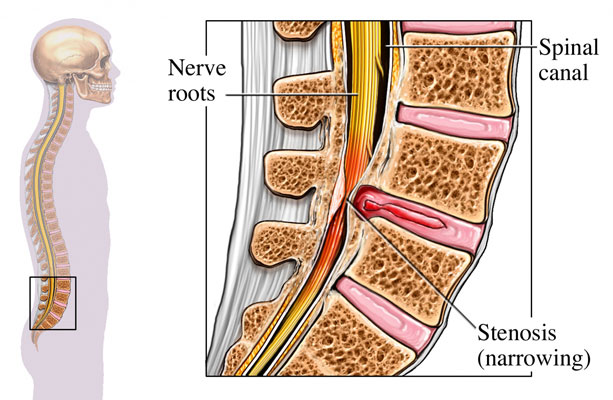What is spinal stenosis?
Spinal stenosis is a medical condition that results in blockage or narrowing of the spinal canal. This spinal canal is a hollow space in the spine through which the spinal cord and nerve roots pass.
Cavity means the existence of a ventilated or empty space within a structure or system. In the case of the spinal canal, which is a part of the spinal column (spinal cord), this space is used as “cavity space”.
The structure of the spinal canal is a long and flat tube that passes behind the spine and contains the spinal cord and nerve roots. This channel is hollow, which means that there is an empty space inside it, which is the place where the spinal cord and related nerve components pass.
Any narrowness or obstruction in this hollow space can lead to pressure on the spinal cord or nerve roots and cause symptoms and complications such as pain, muscle weakness, and changes in sensation and movement. In diseases such as spinal canal stenosis, it is important to diagnose and treat problems in this hollow space.
Symptoms and complications of stenosis or narrowing of the spinal canal
Causes of spinal stenosis
- Aging: aging, the bones and tissues around the spinal canal may undergo changes such as compression and deformation, which causes narrowing of the canal.
- Compact discs:More pressure from the discs enters the spinal canal and reduces its space.
- Malignant masses: The presence of malignant masses such as tumors or benign compounds in the spinal canal region.
- Stenosis of the squirrel canal: This type of spinal canal stenosis is caused by the increase in the size of the canal space when sleeping in a narrow and combined position.
- Abnormal bony compounds: compounds such as vertebral eyebrows or abnormal bone specimens that may narrow the canal space. These compounds refer to components or changes around the bones that cause increased pressure or tightness in different areas of the spine (nerve roots or spinal canal). . These changes may be caused by various factors.
- Structural disorders: Disorders such as damage to ligaments or other abnormal structures in the spine.
Complications of spinal canal stenosis
- the pain: Pain in the back, lower abdomen, or sometimes in the neck, which may spread to the head and buttocks.
- Muscle weakness: Muscle weakness in the legs or arms that may lead to problems with movement and endurance.
- Loss of sensation: Significant loss of sensation or sensation in areas of the body supplied by afferent nerves in the spinal canal
- Difficulty in movement: Problems with movement, balance, and motor strength.
- Aggravation of symptoms with activity: Symptoms of spinal stenosis usually worsen with increased activity, especially during walking or sports activities.
Common treatments for spinal stenosis
They include non-surgical and surgical methods (Spinal Stenosis). Choosing the right treatment depends on the severity and location of the stenosis, individual factors, and the individual’s medical condition. The relevant treatments are mentioned below:
Non-surgical treatments:
- Changes in daily activities: Changing daily activities to reduce pressure and tension on the spinal canal can help relieve symptoms. For example, resting with your feet up, resting on your back, and using standing devices such as spinal stenosis chairs and handles.
- Physiotherapy: Physiotherapy helps strengthen muscles, improve mobility, and reduce pain and muscle tension. Specific exercises to strengthen the back and abdominal muscles are usually recommended.
- medicines: It is common to take non-steroidal anti-inflammatory drugs (NSAIDs) such as ibuprofen as pain relievers and reduce inflammation. In some cases, corticosteroids may be prescribed as stronger anti-inflammatory drugs.
- Palliative injections: Injections such as epidural steroid injections can be effective in relieving pain and inflammation in the spinal canal area. These injections are delayed and help reduce pain and symptoms of tightness.
massage Special massage to reduce muscle tension and increase blood flow to the area may be used as a supplement to other treatments. Gentle massages and special techniques are offered to reduce pain and soothe muscles.
Corrective exercises: Corrective exercises can help strengthen muscles, improve balance, and increase flexibility. Exercises prescribed and taught by a physical therapist help strengthen back and abdominal muscles, improve spinal support, and reduce pressure on the spinal canal.
Water therapy: Exercises in water are usually done with the help of a water therapist. By making the body buoyant, water helps reduce pressure on the joints and spinal canal and relieves pain.
Electromagnetic therapy (electrotherapy): This therapy uses electric and magnetic currents to relieve pain and strengthen muscles.Back belts and compression belts: Using back belts and compression belts may help stabilize the spine and reduce pressure on the spinal canal.
Back belts and compression belts: Using back belts and compression belts may help stabilize the spine and reduce pressure on the spinal canal.


